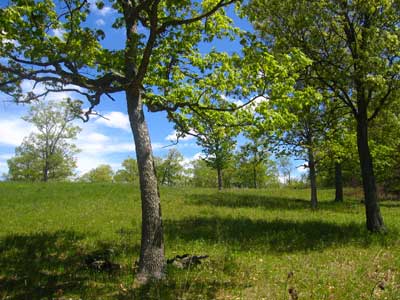Oak Savanna
What is oak savanna?
Oak savanna is defined by scattered oak trees that have broad, spreading branches – or are “open-grown.” A lot of sunlight reaches the ground in oak savanna, typically 50% or more.

The flowers and shrubs growing beneath these open-grown trees can be unique to this level of partial shade.
What maintained oak savanna?
Historically, oak savanna was found throughout southwest Wisconsin – covering nearly 7 million acres – on a range of soil moisture types: dry, dry- mesic, mesic, and wet-mesic.
Frequent fire kept many species of trees from surviving in this plant community. But Wisconsin’s signature savanna tree, the bur oak, is well insulated from the effects of fire due to its thick, corky bark. Moreover, large mammals, such as elk, browsed on shrubs and young trees in the past, helping maintain the savanna’s open, park-like appearance.
Oak savanna is rare today. Savannas on moister soils have been converted to other land uses, such as agriculture. Fire suppression has also allowed former oak savannas to grow into closed canopy woods of maple, basswood, and other shade-tolerant species.
How do I recognize it?
While this plant community is very uncommon now, you can still spot remnants of it. A good place to look is on the south or west slope of a hill, with “savanna trees” being the most obvious clue. Look for large oak trees (bur and white oak) that have large, horizontally outstretched branches. If you find one, the neighboring trees are almost certainly much younger.
What other plants and animals are present in savanna?
Tall anemone, shooting star, woodland boneset, late horse gentian, leadplant, and little bluestem are common wildflowers in oak savanna.
Savannas also provide a unique habitat for some animals, including the brown thrasher, red-headed woodpecker, field sparrow, Blanding’s turtle, bullsnake, northern prairie skink, ornate box turtle, prairie racerunner, prairie ringneck snake, timber rattlesnake, Franklin’s ground squirrel, and the woodland vole.
